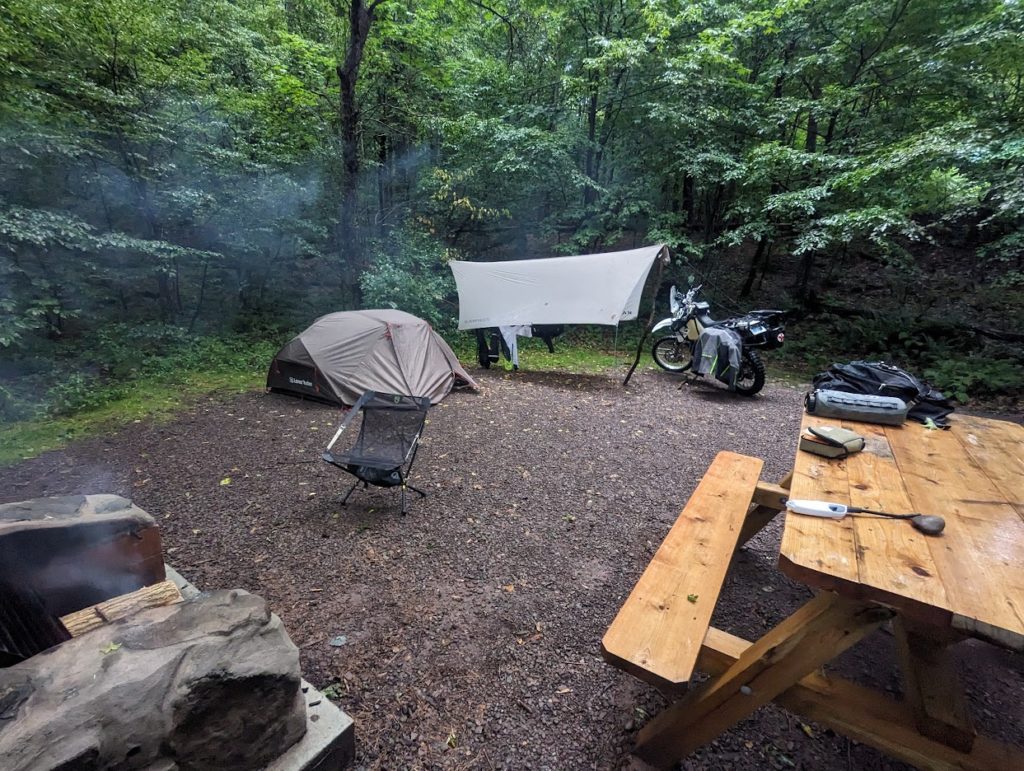The 6,500ish planned miles of this trip will take me across the Great Plains, along the spine of the Rockies, descend through taiga and tundra to the Arctic Ocean, then back up to & across the mountains to reach Anchorage. The climate will change dramatically both from the latitude and the geography, and I’m planning on camping as much as possible throughout the six weeks of the trips. Once I pass Whitehorse, BC, services become scarce if something goes wrong with the bike or with me.
I’ll need to pack more than I usually like to for all of those reasons, but I’m still trying to be as selective as possible about each piece of gear. I don’t want to bring anything I won’t use (other than emergency gear) and each piece of gear will be as lightweight and packable as reasonably possible. I’ll be camping almost every night for six weeks, so I’m willing to make some sacrifices on weight for the sake of comfort. It should still feel like a vacation and not a Victorian expedition.
Note: As of April 2024, this is my rough superset of things I’m planning to pack. My planned setup weights in at around 60lbs including luggage, but that will likely increase on the road once I’m carrying food, water, or extra gas as needed. Even bumping my travel weight up to 75-80 lbs for consumables and any other last-minute things I forgot, I’m pretty happy to be keeping it significantly under 100lbs, which is pretty average for most adventure riders’ kits.
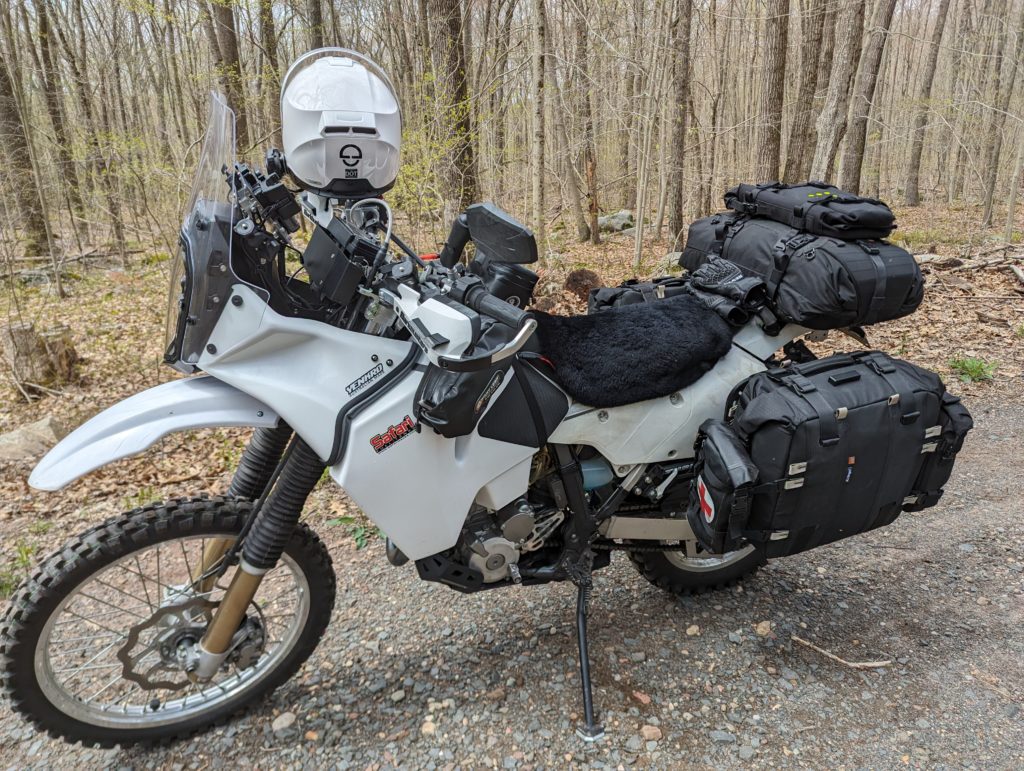
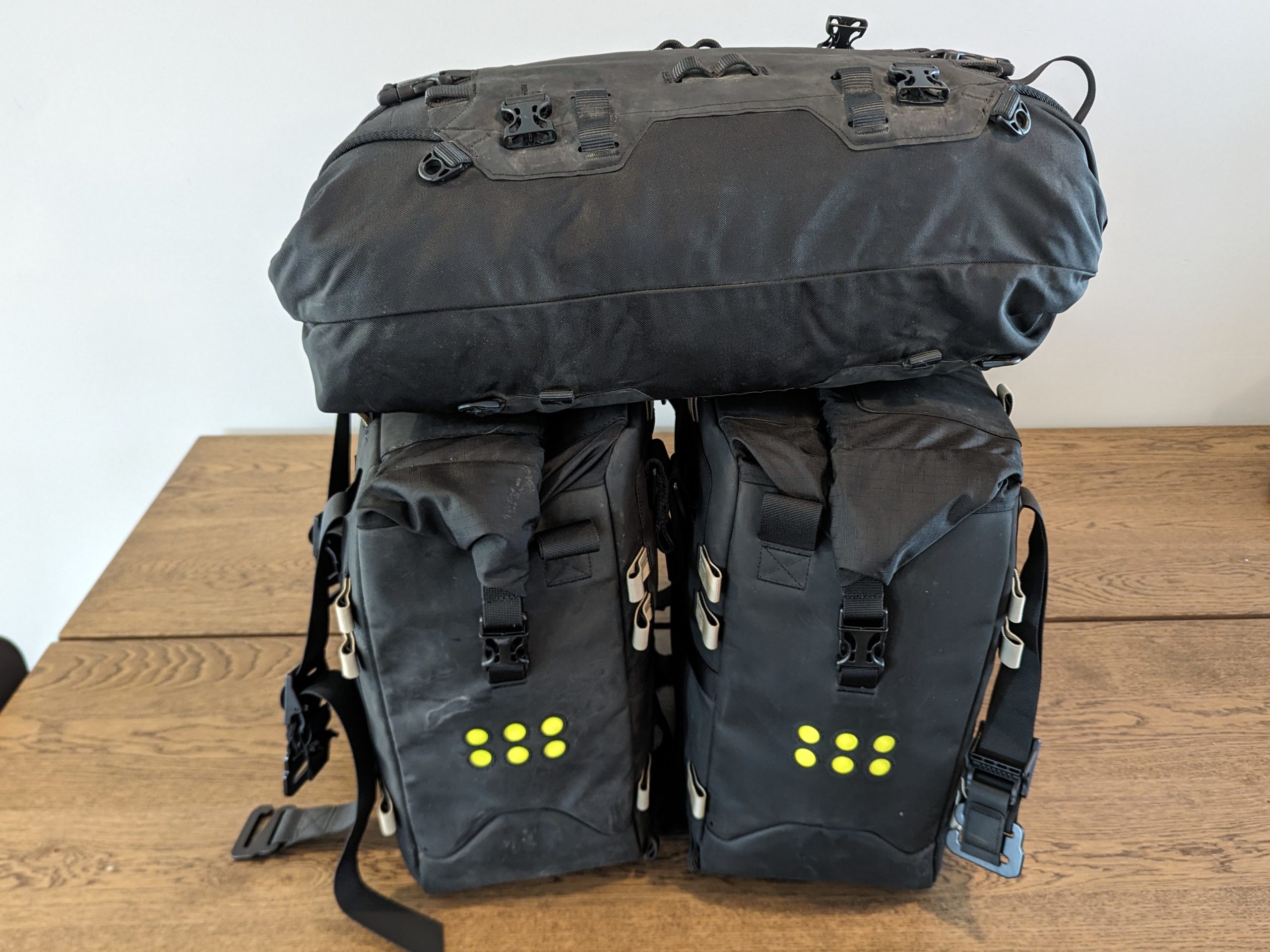
Camping
Sleep System & Furniture
I really like my ultra light (UL) hammock setup, especially for off-road trips, but it’s a bit risky on a long trip since it depends on having good trees. It also makes it harder to keep everything dry & out of sight in large national parks.
My entire sleep system packs into my left pannier, along with some of the other camp furniture (rain fly, chair) and camera gear.
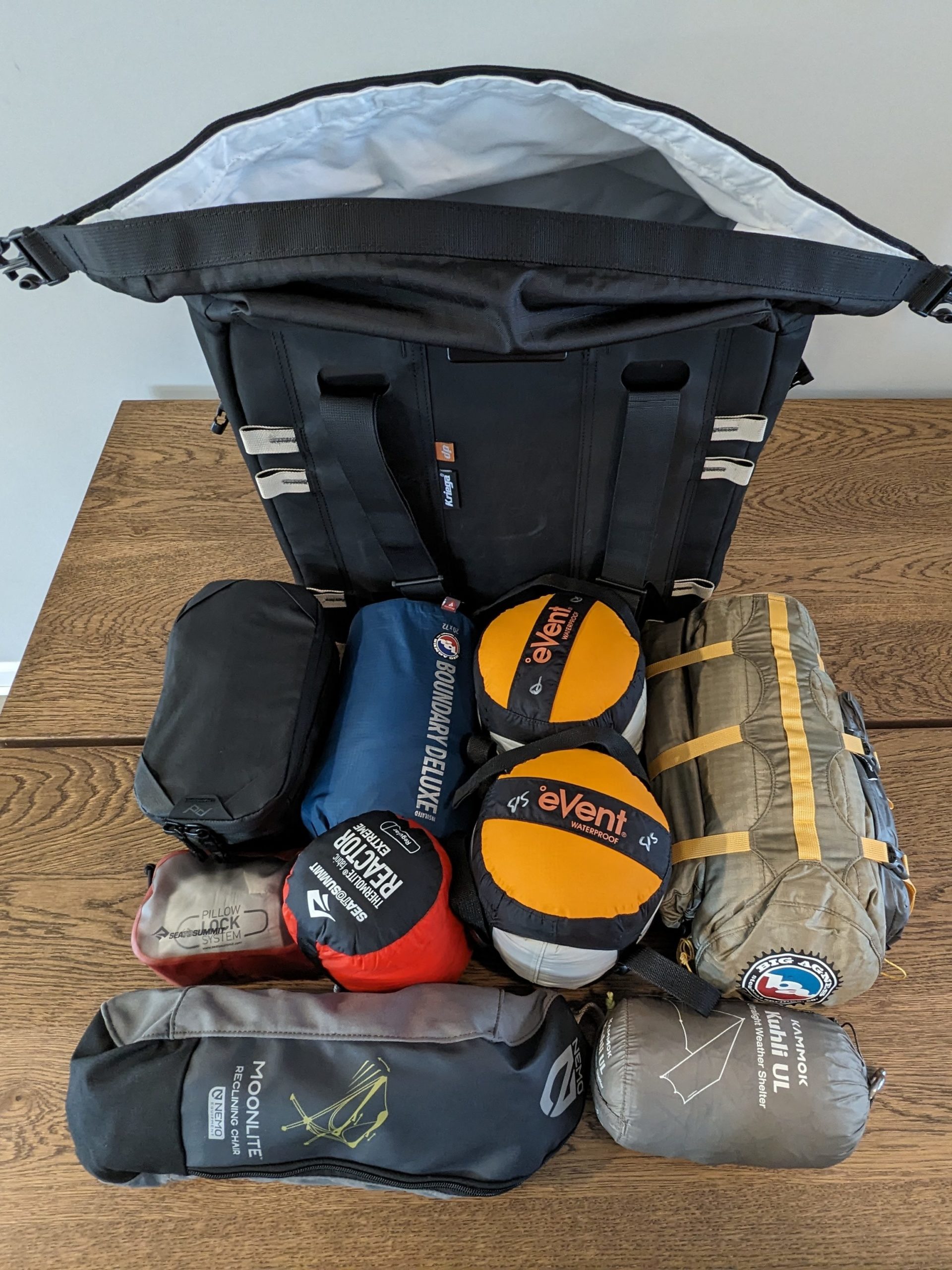
Sleeping Gear
Big Agnes Tiger Wall UL3 Bikepack
The tent is something that I’ve gone back and forth on a lot for this trip. I picked up a Lone Rider ADV 2-person tent last year and used it on my BDR trips — it was relatively reasonably priced and I liked most of the features, but it weighs close to 8 lbs and only packs to 17″x5.5″. After a fair amount of hemming and hawing, I ended up picking up my Tiger Wall UL3 Bikepack on a discount from motocampnerd.com this spring.
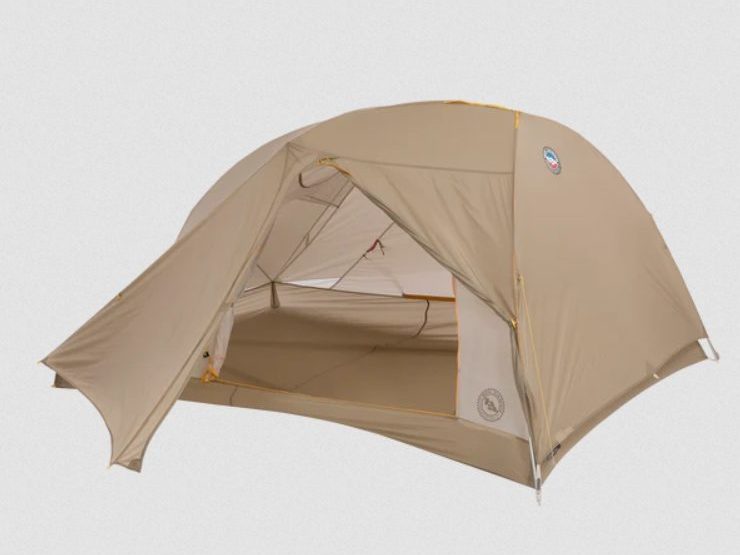
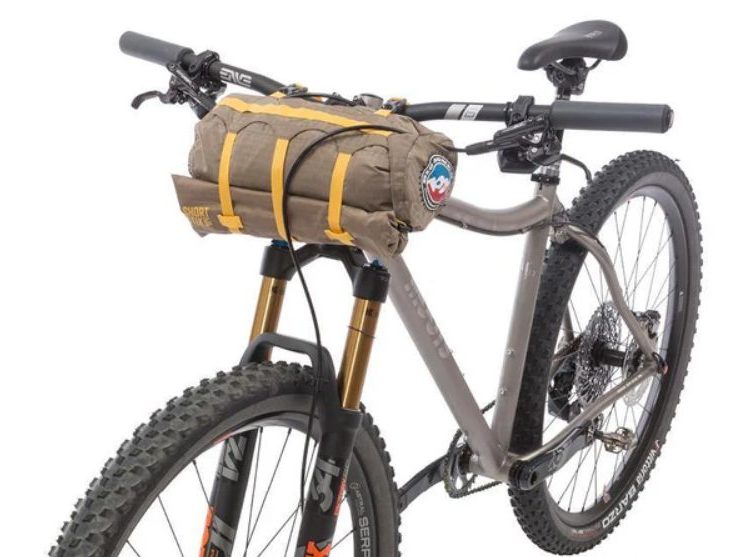
The Tiger Wall UL3 Bikepack is a 3-person tent that packs down to a tiny 13″x7″ bundle (including poles and footprint), which buys back a significant amount of space in my pannier. The tent also weighs about 3.5 lbs with the footprint, which is a significant weight savings compared to my Lone Rider ADV. I get the space and weight savings despite adding more interior and vestibule space, which will make life a bit easier when laying out all my riding gear in the tent.
So far I haven’t had a chance to test the tent, but I’ll update my thoughts and photos once I do. The only potential downside (other than the cost), is that it’s a semi-free standing tent with a triangular pole setup. I tend to stake all my corners anyway, so I don’t see that has a huge issue.
Sleeping Bag: Big Agnes Lost Ranger UL 3N1 15
I tend to sleep warm, move around a lot while falling asleep, and usually end up on my side. Traditional sleeping bags don’t really jive with my sleep style, so I favor quilts whether in a tent or my hammock. The Lost Ranger three-in-one system combines a light quilt with a mummy bag designed for slide sleepers — it’s flexible enough for me to stay comfortable in a range of temperatures while still packing light & small. The entire system is rated to 15 degrees survival / 28 degrees comfort, which should be enough for cold nights in The Rockies. Both layers of bag feature ventilation zippers at the bottom to fine tune temperature.
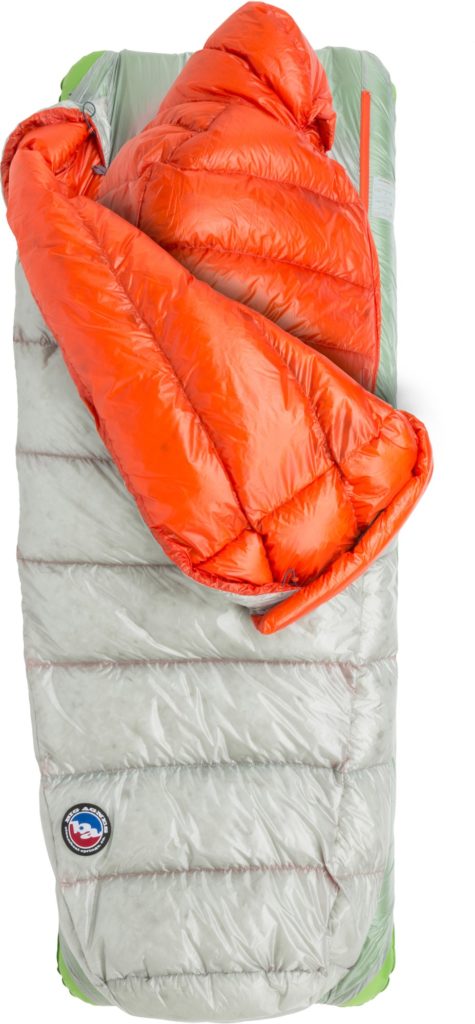
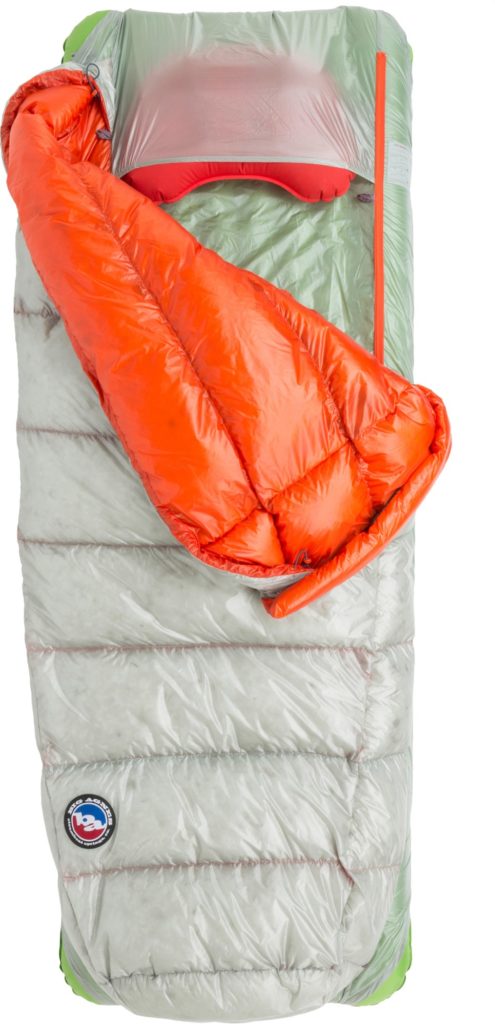
The outer quilt is spacious and rated for 50 degrees on its own, which should be good for most nights (especially when combined with my Thermolite Reactor liner, below). It also features a pillow barn and cinches down to the sleeping pad, keeping it in place for restless sleepers like me.
The inner bag is rated for 35 degrees on its own. Despite being small enough to tuck into the quilt, it doesn’t feel cramped. The bag also features a center zipper which is ideal for side sleeping.
When combined it is a bit snug in a cozy way, but I have spent nights in the 30s and was bordering on too warm with my liner. Each bag packs down to about the size of a softball in a compression sack.
Sleeping Bag Liner: Sea to Summit Thermolite Reactor Extreme
I always use some kind of breathable, moisture-wicking sleeping bag liner to keep my bags clean and keep me from getting clammy. Sea to Summit offers their liners in multiple temperature ratings from the temperature neutral Coolmax Adaptor to the Thermolite Reactor Extreme. All of them pack down to about the size of a large fist, and the extra space is worth it.
For this trip, I’ll bring the Reactor Extreme, which adds 25 degrees of rated warmth to any bag while being lightweight, breathable, and packable. This should extend the range of the Lost Ranger quilt enough that I’ll only need the inner bag if temperatures plummet unseasonably in the mountains.
Sleeping Pad: Big Agnes Boundary Deluxe
The sleeping pad is one place where I’m willing to add a bit of bulk to keep things more comfortable on what is essentially a six week camping trip. The Boundary Deluxe packs slightly larger than an UL inflatable backpacking pad, but it’s rectangular shape and four inches of thickness make it much more comfortable for a side sleeper like me.
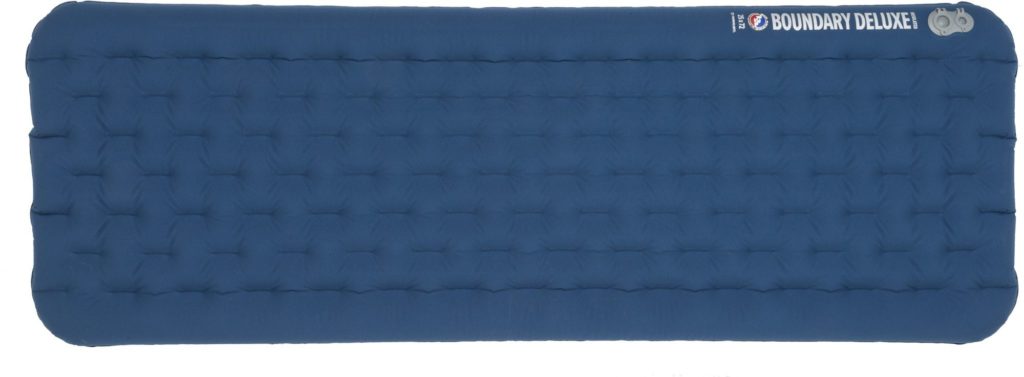
It’s also surprisingly quiet, with quilted fabric top to help with airflow and keep the squeaking to a minimum. The bag is insulated and has an R value of 4.3, which should be plenty warm enough for this trip.
Pillow: Sea to Summit Aeros Down Pillow
The Aeros Down pillow packs down tiny but adds a lot of comfort & warm with the down-insulated top layer. At 2.5oz, it’s a luxury that doesn’t make sense not to bring.
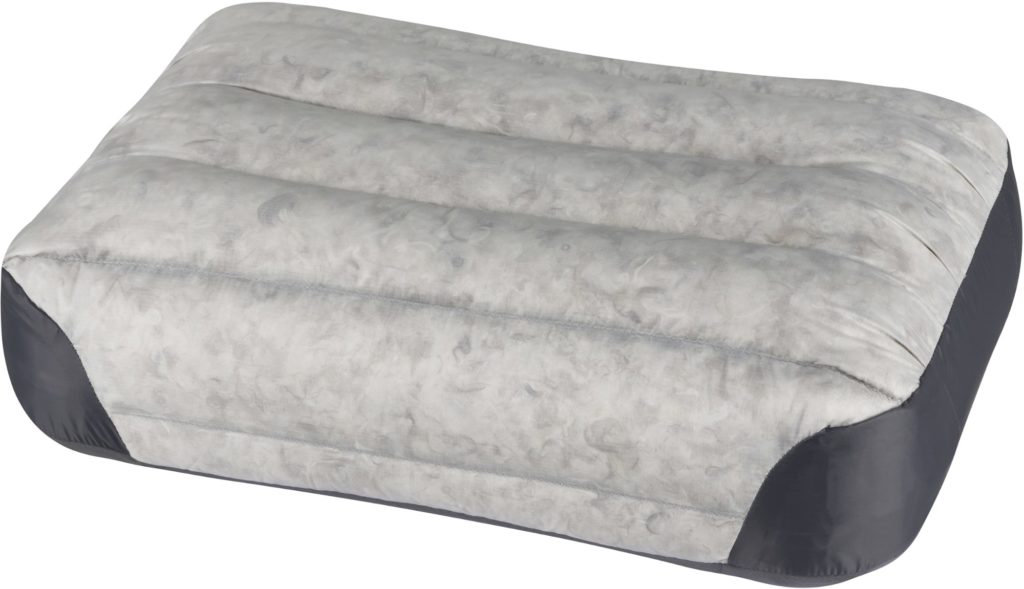
Other Camp Furniture
Rain Fly: Kammok Kuhli
Packs to the size of a Coke can and works great over a picnic table or stretched between trees to let gear air out even when it’s raining. As far as I can tell, the Kuhli is exactly the same as the rain fly for the Kammok Mantis hammock, and hangs with integrated knotless lines. Both have kept me dry in pretty gnarly downpours.
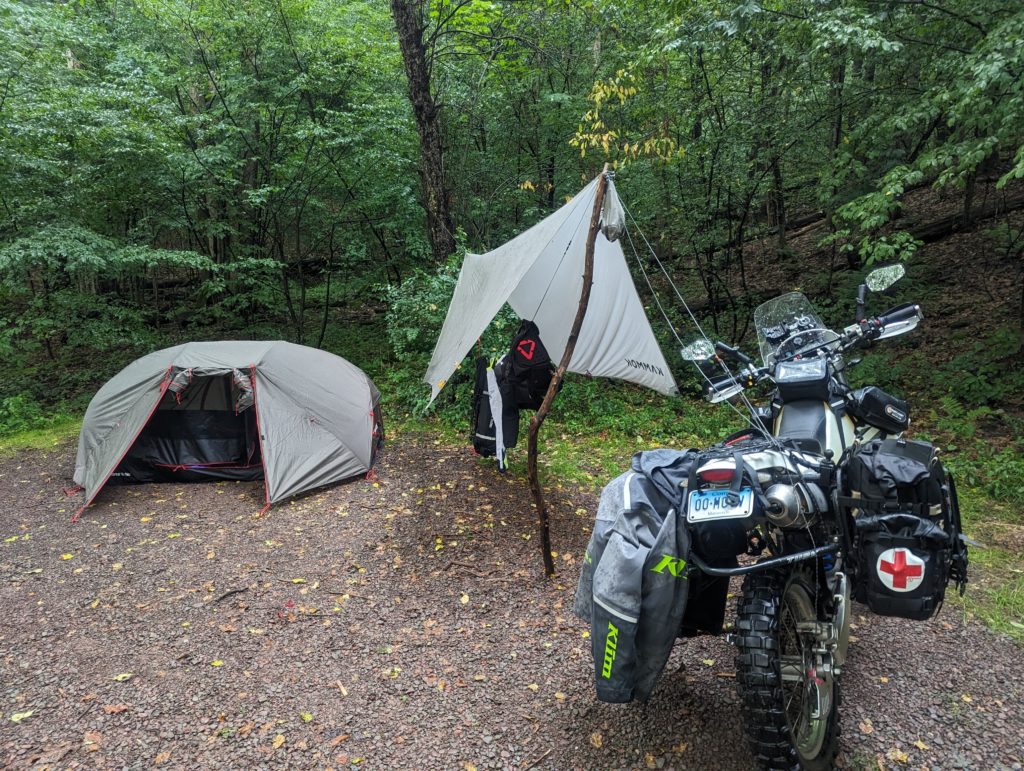
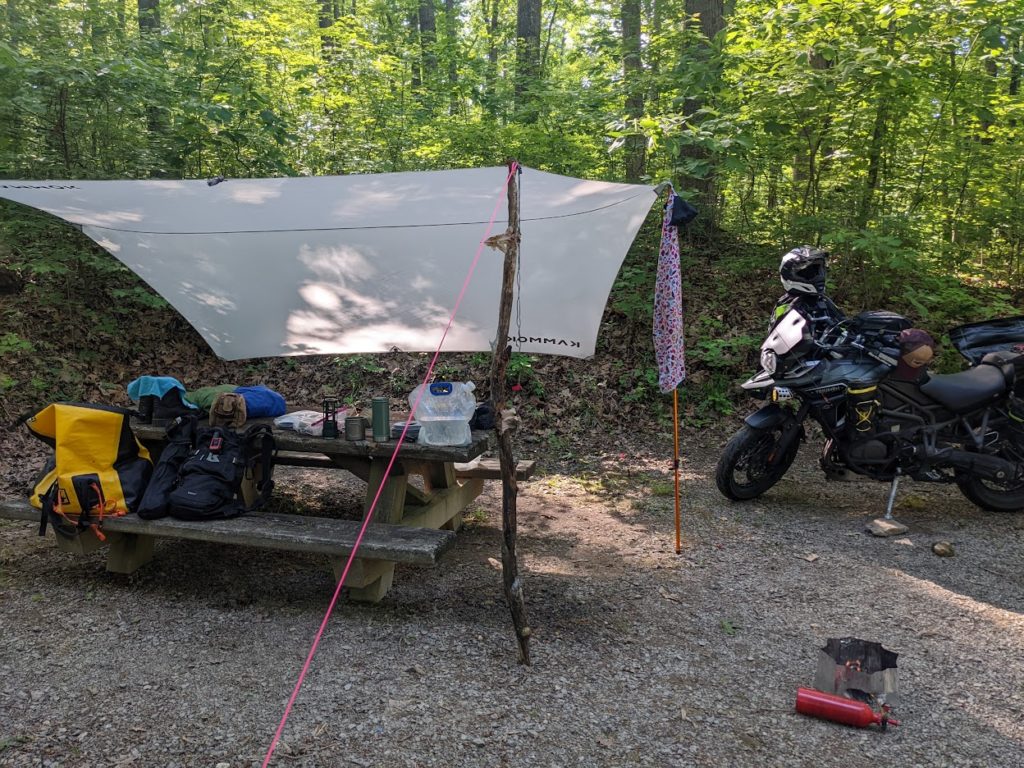
Chair: Nemo Moonlite
I’m getting old enough that sitting on nothing but motorcycles, stumps, and picnic tables for days isn’t kind to my back. This mesh-backed reclining chair packs small enough to justify carrying and makes for a much more comfortable campsite.
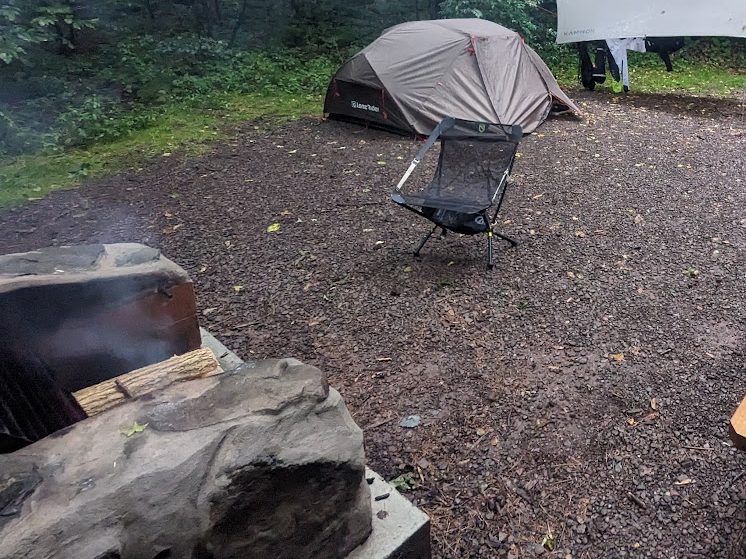
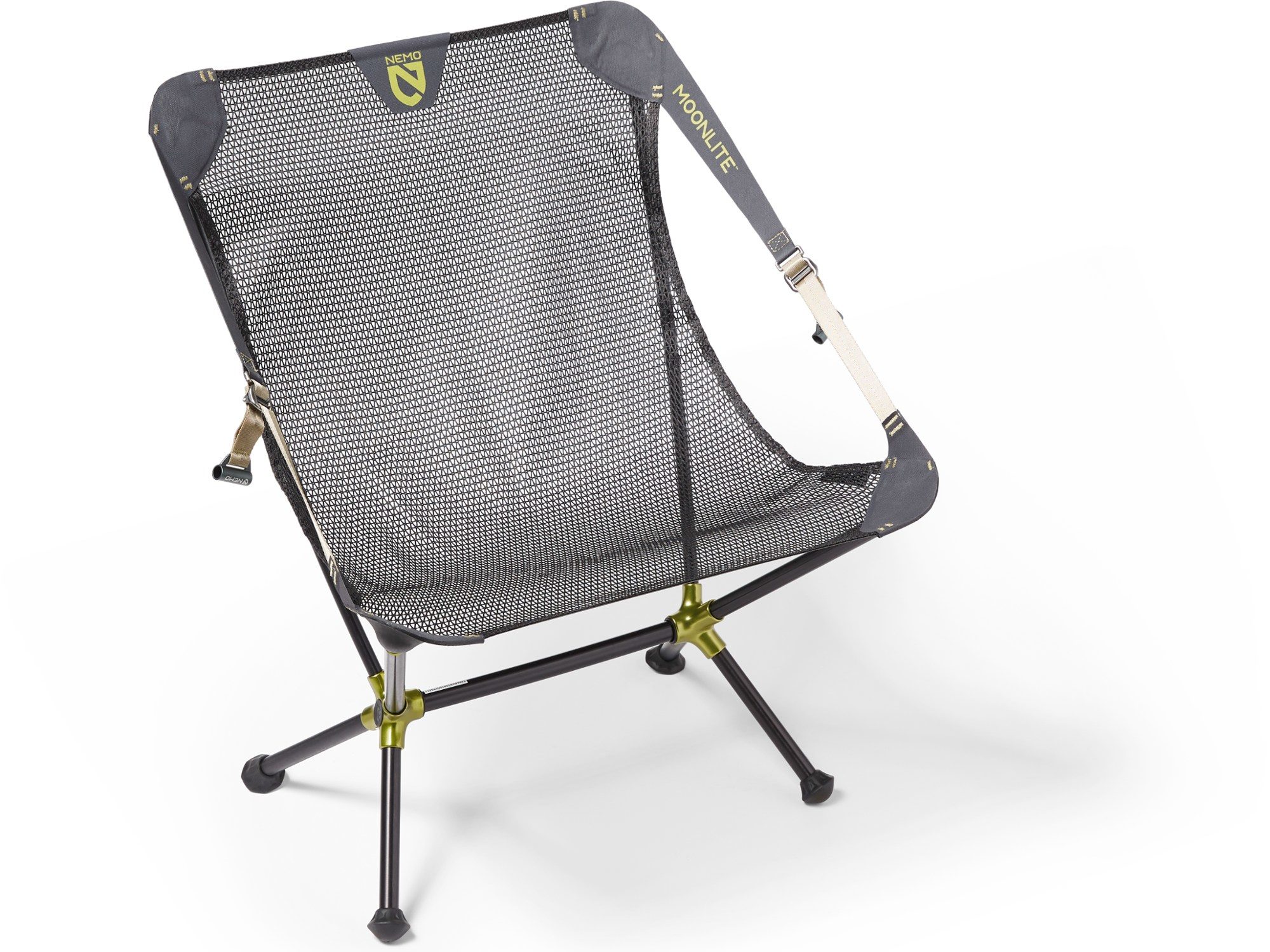
Camping Gear
The rest of my camping gears gets organized by function into waterproof packing cubes, and stows in my right pannier. My Toiletries, spare parts, and bike chemicals also get packed in this pannier to keep their weight low.
This organization strategy also helps keep anything smelly one pannier and away from my tent & clothes to minimize bear/animal risk. Note that anything with strong scents is packed into separate scentproof bags which can easily thrown into a larger scentproof bag and into my Ursak bearproof bag.
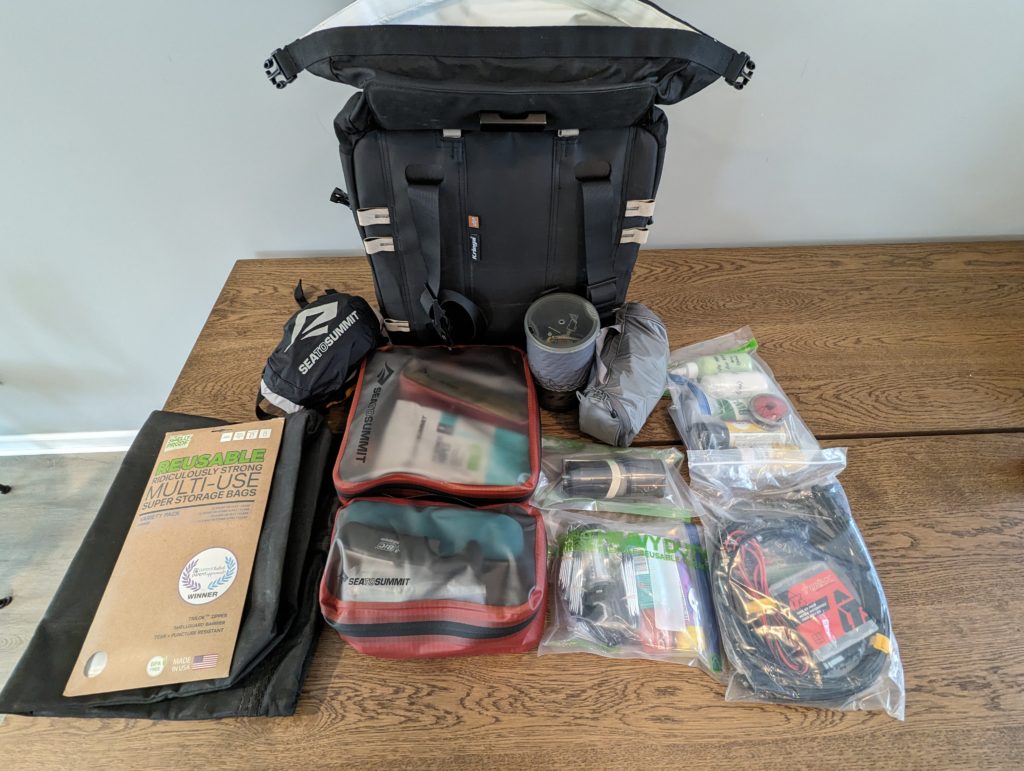
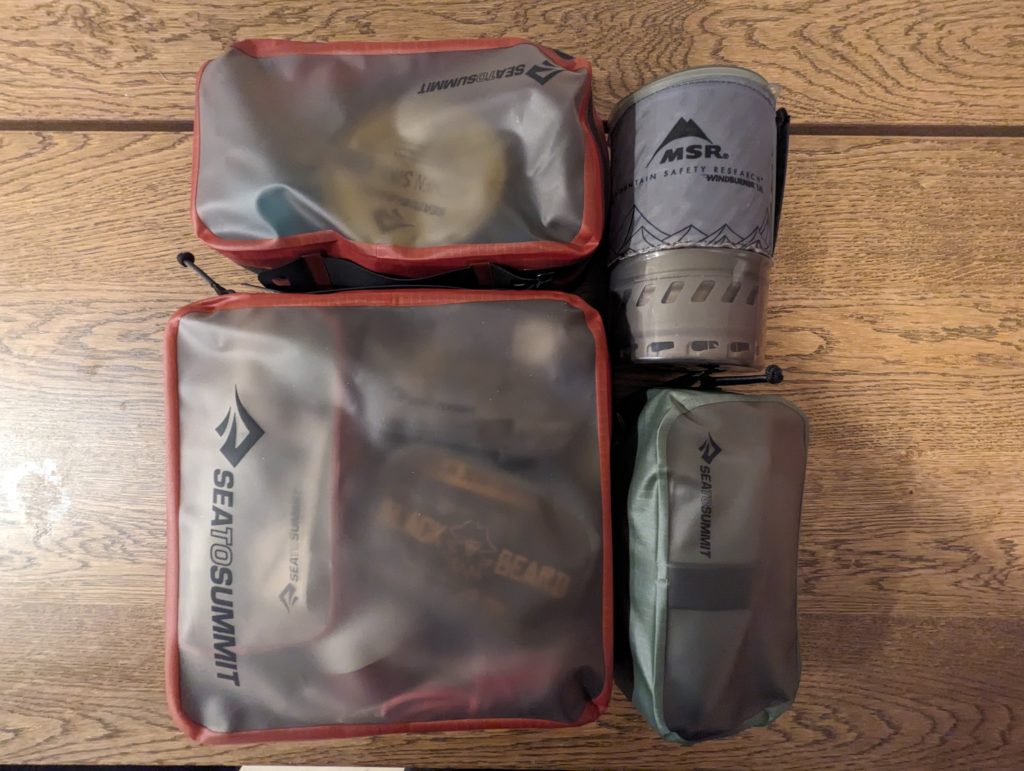
Kitchen
I mostly intend to eat on the road in restaurants, but I’ll need to be able to heat water for coffee and the occasional cup of noodles or backpacking meal.
- MSR Windburner Stove & Fuel
- Sea to Summit X-Seal & Go, XL & medium dishes (nested)
- Sea to Summit Pot Scrubber & Brush (and soap)
- Sea to Summit Airlite Towl, small
- Sea to Summit Aluminum Utensils
- Stanley French Press Mug , GSI Outdoors coffee grinder (not pictured)
- Giant Loop Cactus Canteen (1gal) for camp and to pack water on the Dempster
- Hydrapak Seeker water reservoir (with integrated filter)
- Sawyer Squeeze Mini water filter (for hydration pack or Cactus Canteen) with bottle adapters
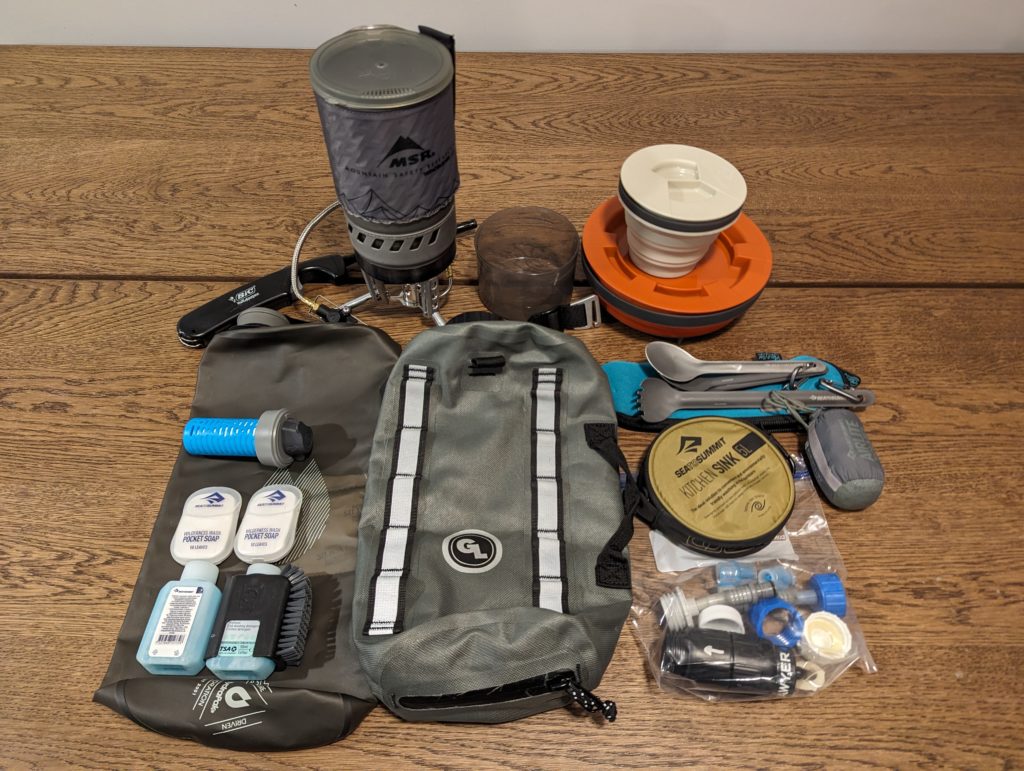
Miscellaneous Camping Gear
For life in camp and general comfort:
- Laundry: Scrubba Wash Bag & Sea to Summit dry soap leaves, Sea to Summit Travel Clothesline
- Tools: Gerber Gear Pack hatchet, Bradford Guardian 4.5 camp knife, SOL portable chainsaw
- Toiletries & Airlite Towl, Large (pictured above)
- Headlamp & small REI lantern
- Fire starters, waterproof matches
- Ursak bear- and critter-proof hang back with OPSak oder-proof bags for food & other smelly things (pictured above)
- Bear spray (not pictured)
- Emergency Supplies: Tenacious Tape gear repair tape, duct tape, glow sticks, emergency blanket, hand warmers
- Spare tent stakes & parachute cord
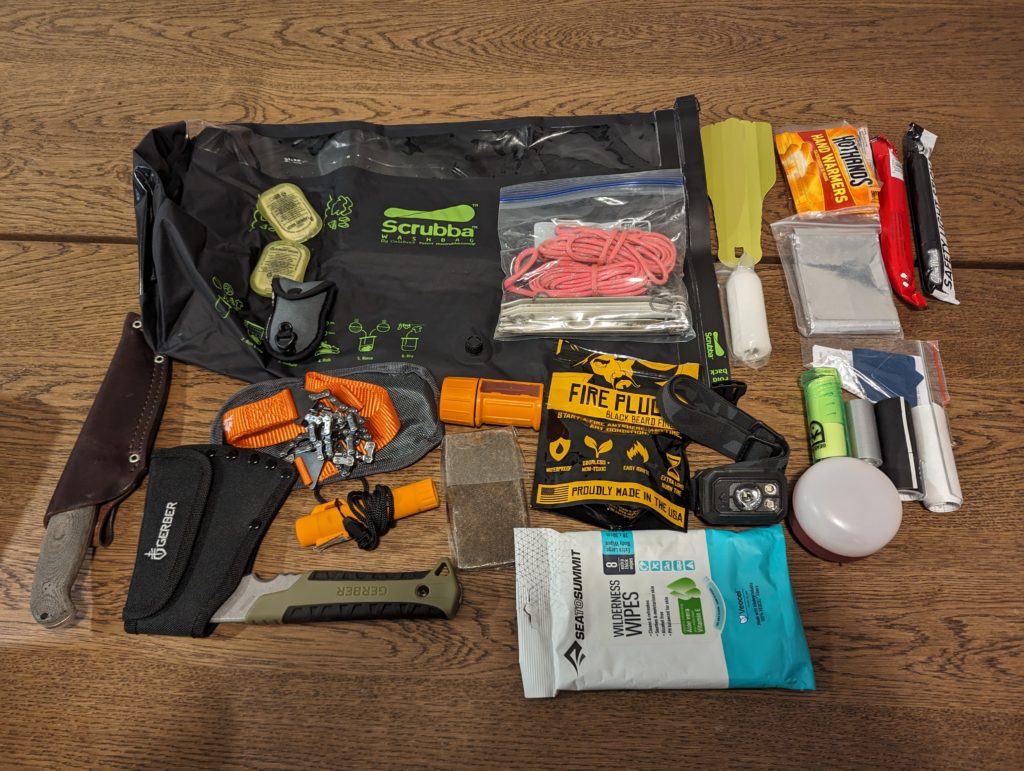
Clothes
All of my travel gear is lightweight, moisture wicking, and anti-microbial. Merino wool, synthetics, and blends of the two are perfect for this kind of trip — cotton is heavy and retains moisture & odors, I try to avoid it. Riding gear is probably a totally separate post, so I’ll focus on base & mid layers along with camp clothes.
All of my clothes pack into the duffel bag strapped to my tail rack. This makes it easy to just grab all of my clothes at once when setting up camp or unloading into motel/AirBNB. This also helps with weight distribution since clothes are bulky but relatively light.
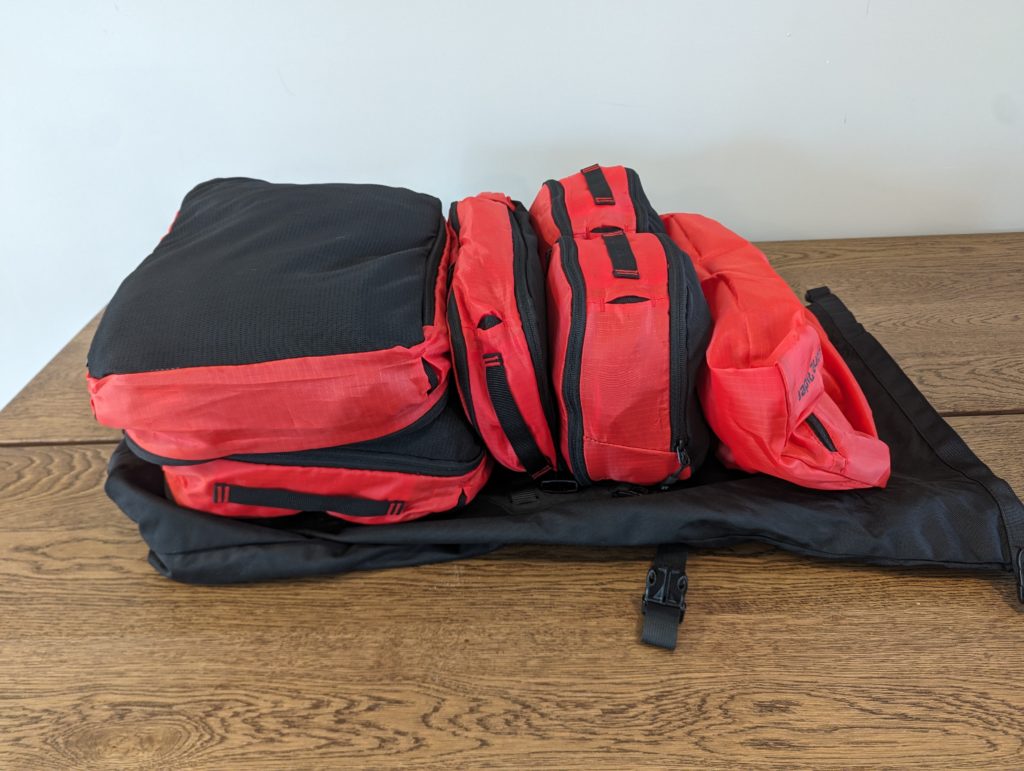
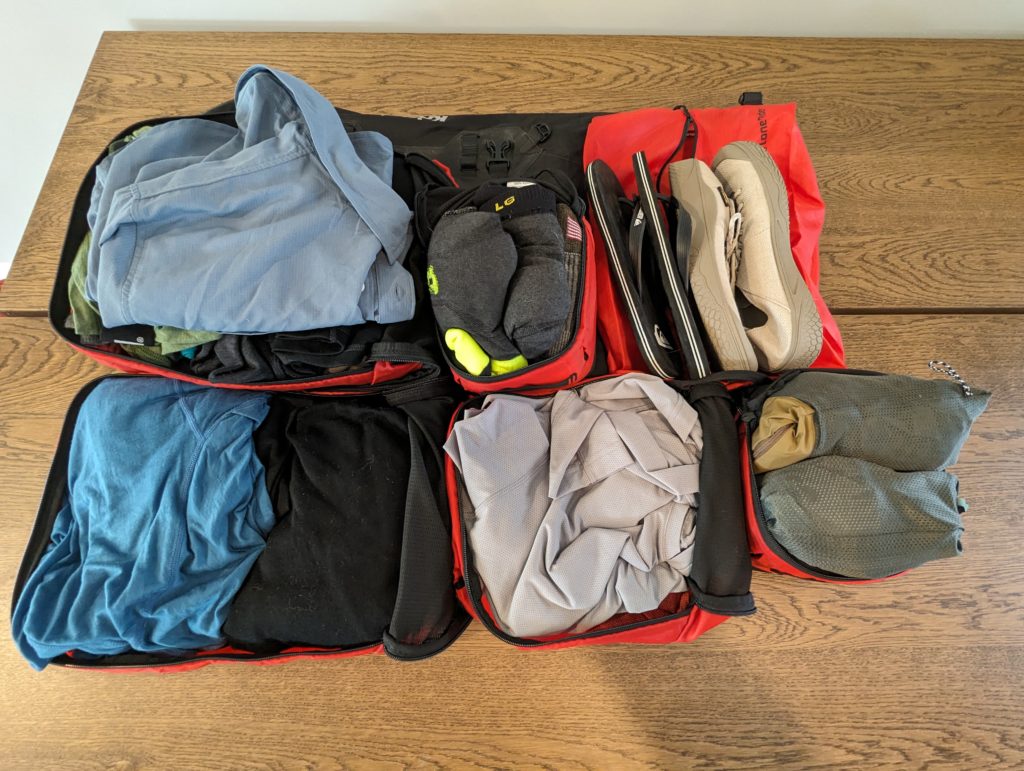
Base Layers
Whether the temperatures are hot or cold, base layers help regulate temperature and manage perspiration. Each set of base layers consists of socks, full length bottoms, and a long sleeve top. I’ll also have at least one pair of extra socks for each set. The long length for the pants & sleeves help facilitate cooling & moisture wicking, and it also helps keep riding gear fresh by trapping the sweat until it evaporates.
Because of their quick drying and antimicrobial properties, I should be able to get by with just a few pairs by airing my outfit after each ride and washing once a week (off-road trips require a bit more washing, but this should be less sweaty).
- Hot weather: two pairs, lightweight, cooling synthetic
- Temperature Neutral: two pairs, 150gsm merino wool
- Cold Weather: one pair, 250gsm merino wool
Mid Layers
The average high temperatures for most of the trip will be in the around 70F, but I’m expecting chilly evenings at camp and mornings riding. Packable insulating layers will keep my cozy layered under riding gear or rain/wind shells at camp.
- Aerostich TLTec Wind Stopper Fleece Pants
- Outdoor Research SuperStrand LT Jacket
Camp Clothes
I’m hoping to pace this trip out enough to have plenty of time in camp or in town to explore. While I might skip out on camp clothes for an off-road focused trip where packing as light as possible is important, I very much value being able to change out of riding gear after a long day in the saddle. Keeping separate camp clothes also means that my riding gear doesn’t end up smelling like campfire.
Hiking & trail running clothing is great because it’s still lightweight & packable while looking more casual.
- Shoes: Teva Canyon sneakers, flip-flops for camp showers
- Pants: Outdoor Research Ferrosi pants (1 pair), joggers (1 pair), and shorts (1 pair)
- Shirts: One 250gsm long sleeve merino hoodie, one short sleeve merino blend t-shirt
- Two pairs each of wool socks & boxers
- Rain/Wind Shells: Outdoor Research Foray pants, StratoBurst Stretch jacket
Tools & Spares
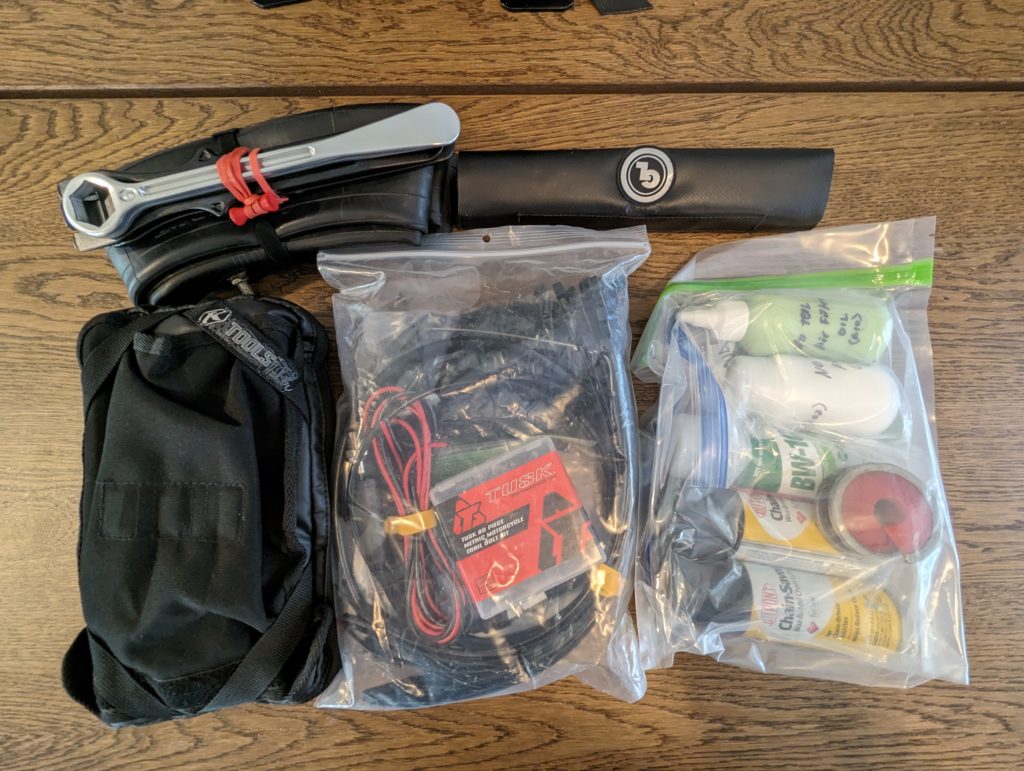
Spares
Spare parts will be few and far between as I go North, so I want to make sure I pack for common mechanical issues. Especially important are wear items that may be hard to replace on the road, but will stop me in my tracks if they fail early.
- Assorted nuts & bolts
- Marine grade wire & connectors
- Spark Plug
- Clutch & Throttle Cables
- Inner tubes (front & rear)
- Giant Loop Armadillo fuel bag (2gal)
- Assorted fuses
- Chain master link
Tools & Chemicals
My toolkit is made up of lightweight combination tools that should be able to do everything on my bike up to taking the engine apart (honestly I could get at least the top end apart, it’s putting it back together right that’d worry me).
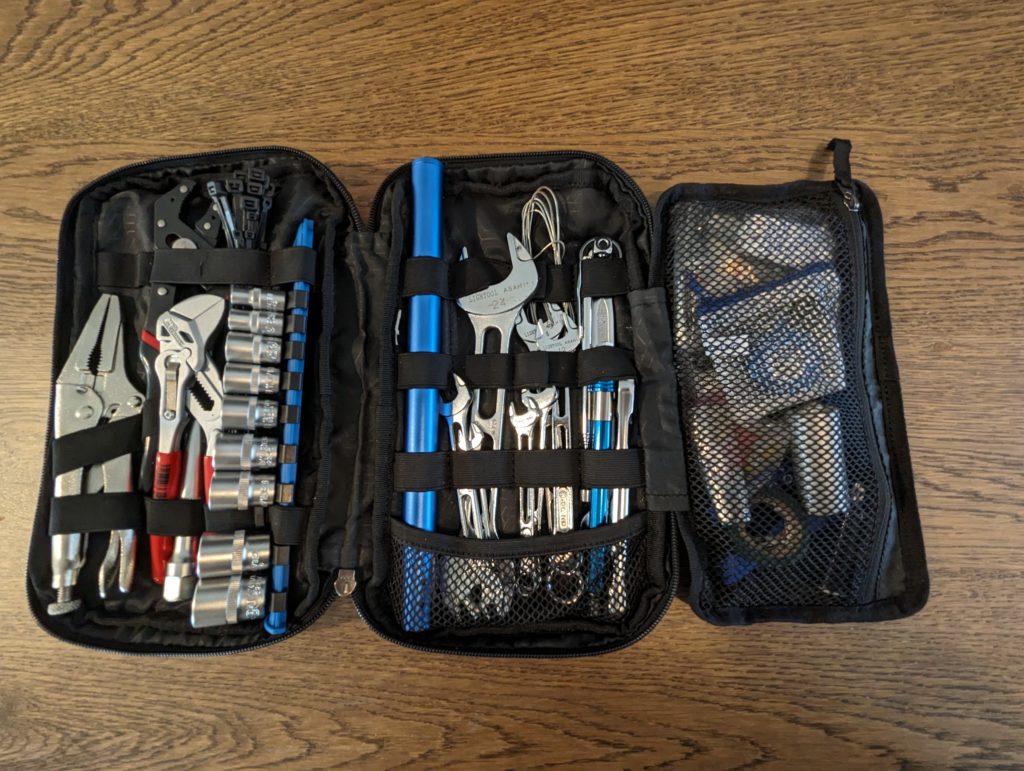
My typical toolkit for day-to-day riding and short trips is a bit lighter that what’s pictured above. In addition to the usual hand tools, I’ll bringing:
- JB Weld quick set epoxy & putty
- Small tube of copper anti-seize
- Small tube of dialectic grease
- Loctite stick
- Contact cleaner (travel size)
- Chain Lube & chain brush (travel size)
- No Toil Air filter cleaner & biodegradable oil (travel size)
- Trail Stand
- Bead Breaker & Tire Irons w/ axle wrench
- Tow strap
- Trail Tech tire inflator
